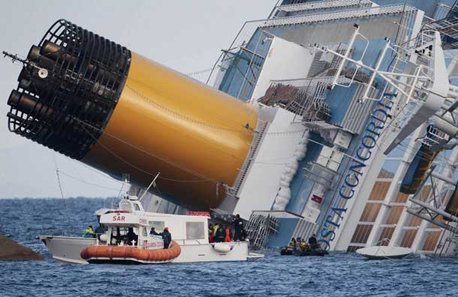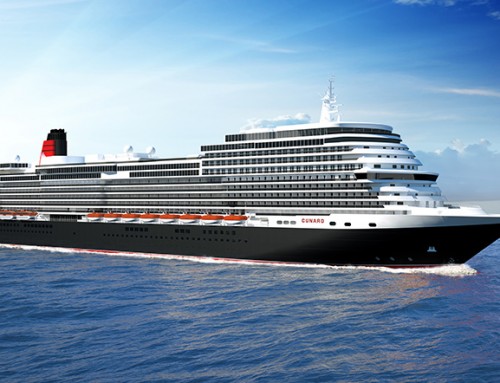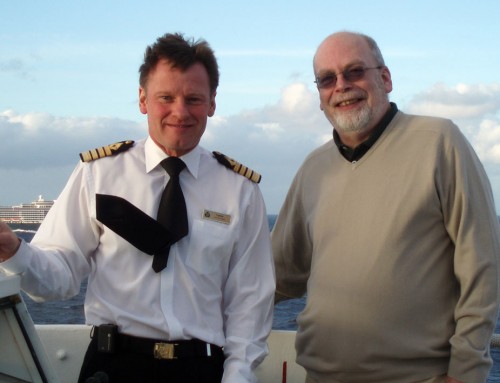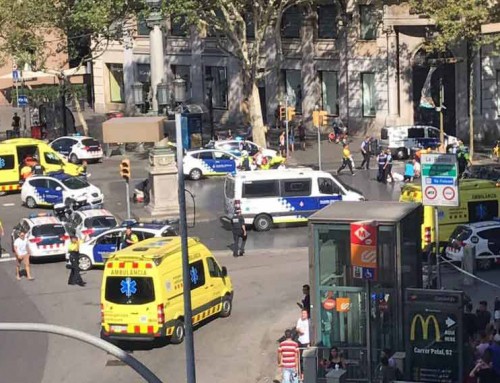 As the confirmed death toll from the Costa Concordia tragedy reaches 16, and salvage experts begin the task of safely removing 2,400 tons of fuel oil from the ship, it’s time to start looking for some answers from Costa and the cruise industry as a whole. Seemingly shocked by the scale of the disaster and the recklessness of Captain Schettino, they appear to have spent the past week avoiding some serious issues rather than confronting them.
As the confirmed death toll from the Costa Concordia tragedy reaches 16, and salvage experts begin the task of safely removing 2,400 tons of fuel oil from the ship, it’s time to start looking for some answers from Costa and the cruise industry as a whole. Seemingly shocked by the scale of the disaster and the recklessness of Captain Schettino, they appear to have spent the past week avoiding some serious issues rather than confronting them.
Where, for example, is Micky Arison, Chief Executive of the Carnival Corporation which owns Costa Crociere? With a personal fortune estimated at $5.9 billion (£3.8 billion) he is ranked the 169th richest person in the world by Forbes magazine, and is a recent convert to Twitter, where he would boast in equal measure about Carnival and his other great love, the Miami Heat basketball team which he also owns.
But a week ago he tweeted: “I won’t be as active on Twitter for the next while. Helping our @costacruises team manage this crisis is my priority right now.” After announcing a “comprehensive review” of all safety and emergency response procedures across its nine cruise lines and 101 ships he remained silent until late on Tuesday (January 24) when he re-surfaced to deny newspaper reports that passengers on the doomed cruise had been offered a 30 per cent discount on future bookings.
Carnival’s Facebook page announced on January 19 that “out of respect for all those affected by the recent events surrounding our sister line, Costa Cruises, we are going to take a bit of a break from posting on our social channels.
“We will still be actively listening and answering any questions you have about your past or upcoming cruises, but for now, the majority of our time will be spent focusing on all those affected by this event. We thank you again for all your support.”
Five days later, a new message was posted: “During the last two weeks, the amount of support all of you have shown has been truly amazing – and we thank you from the bottom of our hearts. Our sister line, Costa Cruises, and parent company Carnival Corporation & plc, remain focused on taking care of all guests, crew and the families affected by this tragic event.
“In addition to saying thank you to everyone, we’ve decided to resume some posting on our social channels – and will start back up by answering your questions about cruising and Carnival, as well as providing you with content and resources to help you better prepare and plan for your upcoming vacations. We thank you again for your continued support. We have the best fans in the world.”
Costa themselves have employed Clarence Mitchell, the communications expert best known for representing Kate and Gerry McCann during the media storm which followed the disappearance of their daughter Madeleine.
His role so far has been largely to brief against Schettino in order to convince the world of the captain’s reckless actions and divert scrutiny away from the behaviour of the company and the safety of other ships – Costa Serena, Costa Pacifica, Costa Favolosa and Carnival Splendor – which are built to the same basic design as Concordia.
Revelations that Friday January 13 was not the first time Concordia – or indeed other Costa ships – had sailed dangerously close to the island of Giglio may eventually undermine this strategy. And there are legitimate questions as to whether there was an underlying lack of discipline in the organisation which permitted, and possibly even encouraged, Schettino’s cavalier style of captaincy.
Splendor, incidentally, is the ship which was knocked out of action in November 2010 by an engine room fire. The ship – christened in Dover by Myleene Klass in 2008 – drifted off the west coast of Mexico for several hours without power and had to be towed to safety in San Diego. The ship was out of service for four months while repairs were carried out – including the fitting of a new engine which had been destined for Carnival Breeze, under construction in Trieste.
Imagine the relief at Costa Crociere and Carnival Corporation when it became clear that Concordia’s accident was not the result of a similar failure.
There has been speculation that Concordia will be salvaged and returned to service. Arison’s statement to the stock exchange last week, anticipating financial losses for Carnival approaching a billion dollars, said: “A damage assessment review of the vessel is currently being undertaken to determine how long it will be out of service …
Other reports suggesting passengers booked on future Concordia cruises have been offered a 30 per cent discount, and that Costa neoRomantica, currently undergoing a €90 million refit, will be drafted in from March as a substitute for Concordia, do not reflect well on Costa’s thinking. I have yet to see any announcement about the planned launch of sister ship Costa Fascinosa – another variation on the Concordia design – scheduled to take place in May.
The UK’s Passenger Shipping Association has concentrated on assuring consumers that despite this one-off tragedy, cruising is still intrinsically safe. Surveys of cruise specialist travel agents, showing little or no reduction in booking inquiries over the past few days, suggest that the strategy is succeeding.
But it would be surprising if holidaymakers who have yet to “choose to cruise” do not pause for thought, and it may be that UK cruise lines in particular will need to re-focus their marketing strategies on their loyal regular cruisers, for the time being at least.
Because I was away in the Caribbean – cruising on Allure of the Seas – I was unable to accept an invitation from “the global cruise industry” to a media briefing in London with a panel of experts “covering the safety regime for cruise ships.”
To be honest, I doubt if I missed a great deal; the invitation went on to state: “We will not be in a position . . . to comment or speculate on the Costa Concordia incident.”
Captain Bill Wright, senior vice-president of marine operations at Royal Caribbean was there to defend modern cruise ship design, and to reassure us that lessons would be learned from “the incident.”
Almost as if in response, Siim Kallas, European Commissioner for Transport, demanded that an on-going EU review of passenger ship safety legislation should take account of Concordia – in particular the issues of design and stability, emergency evacuation procedures, and crew training.
Meanwhile, Royal Caribbean president Adam Goldstein is the only Carnival competitor to have so far made a public statement, in which he describes the Costa Concordia accident as “a defining moment in the history of the modern cruise industry.
“We will need the results of the authorities’ investigations to truly understand and respond to all of the implications,” he said in his blog. “But we do not need to wait for anyone or anything to underscore the pre-eminent role of safety in the daily life of every cruise ship and of the industry as a whole.”
So, there have been plenty of assurances about passenger safety being of “paramount importance,” and lots of questions about how and why the grounding could have happened.
Now it’s time to expect some answers.






It is interesting how this catastrophe relates to the Titanic and Columbia Shuttle, both of them were also caused by a chain of bad human decisions.
I recommend you this book that explains what happened there and it gives some clues of what could be going on the Costa Concordia:
http://www.amazon.com/Iceberg-Sighted-Decision-Making-Techniques-ebook/dp/B0064AS8CM
It was suggested to us by a crew member that we start digging into the past of Carnival Cruise and that is what we are doing . John we have only just started and what a can of worms.
http://costaconcordiaimbroglioni.blogspot.com/2012/01/carnival-cruise-liner-their-sordid-past.html
I listened in on the cruise safety seminar and wrote up a story from it for our trade site. It mainly focused on how large ships are no more dangerous than small ones (had been mentioned in some press reports) and that it wanted a safety review.
Cruise.co.uk says its searches for cruises are relatively unchanged but not sure if these have converted to bookings…
Large ships are no more dangerous than small ones?
Give me a break.
I was onboard Cunard’s Queen Victoria last Jan – from Southampton to NY.
It would have been everyman for themselves.
Carnival Corp hires people at slave wages and if you think – with the sailing I was on… majority over 60 – would have gotten off in the storms we faced… you are madly mistaken…
The Costa Concordia had 1000 crew for 4000 passengers. And these giant ships… without lights – are a maze! And deathtraps.
These aren’t the Queen Mary of the past. The crews are anything but trained nationals of one country but a polyglot of people who will head for the lifeboats first.
As for Cunard – its not even British but run out of a suburb in Los Angeles. Stay off these large ships… if the Costa Concordia was caught in hurricane or fire… it would make the Titanic look like child play…